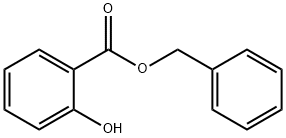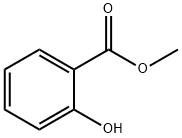Benzyl Salicylate , >99.0%(GC) , 118-58-1
Synonym(s):
Benzyl 2-hydroxybenzoate
CAS NO.:118-58-1
Empirical Formula: C14H12O3
Molecular Weight: 228.24
MDL number: MFCD00020034
EINECS: 204-262-9
| Pack Size | Price | Stock | Quantity |
| 5G | RMB27.20 | In Stock |
|
| 25g | RMB39.20 | In Stock |
|
| 100G | RMB48.80 | In Stock |
|
| 500G | RMB204.00 | In Stock |
|
| 2.5KG | RMB857.60 | In Stock |
|
| others | Enquire |
PRODUCT Properties
| Melting point: | 18-20 °C |
| Boiling point: | 168-170 °C5 mm Hg(lit.) |
| Density | 1.176 g/mL at 25 °C(lit.) |
| vapor pressure | 0.01Pa at 25℃ |
| FEMA | 2151 | BENZYL SALICYLATE |
| refractive index | n |
| Flash point: | >230 °F |
| storage temp. | -20°C |
| solubility | Chloroform (Slightly), Methanol (Slightly) |
| pka | 8.11±0.30(Predicted) |
| form | Liquid |
| color | Thick colorless liquid |
| Odor | pleasant odor |
| biological source | synthetic |
| Odor Type | balsamic |
| Water Solubility | Slightly soluble |
| Merck | 14,1144 |
| JECFA Number | 904 |
| BRN | 2115365 |
| Dielectric constant | 4.1(20℃) |
| InChIKey | ZCTQGTTXIYCGGC-UHFFFAOYSA-N |
| LogP | 4 |
| CAS DataBase Reference | 118-58-1(CAS DataBase Reference) |
| NIST Chemistry Reference | Benzoic acid, 2-hydroxy-, phenylmethyl ester(118-58-1) |
| EPA Substance Registry System | Benzyl salicylate (118-58-1) |
Description and Uses
Benzyl salicylate is a salicylic acid benzyl ester, a chemical compound most frequently used in cosmetics. It appears as an almost colorless liquid with a mild odor described as "very faint, sweetfloral, slightly balsamic" by those who can smell it, but many people either can't smell it at all or describe its smell as "musky". Trace impurities can have a significant influence on the odour.[1] It occurs naturally in a variety of plants and plant extracts and is widely used in blends of fragrance materials.
There is some evidence that people can become sensitized to this material and as a result there is a restriction standard concerning the use of this material in fragrances by the International Fragrance Association.
It is used as a solvent for crystalline synthetic musks and as a component and fixative in floral perfumes such as carnation, jasmine, lilac, and wallflower.
benzyl salicylate is a fragrance found naturally occurring in carnations and in certain members of the primrose family. Although it can be derived for cosmetic use from natural essential oils, such as jasmine oil, neroli, and ylang-ylang, it can also be synthetically manufactured.
Safety
| Symbol(GHS) |  GHS07 |
| Signal word | Warning |
| Hazard statements | H317-H319-H412 |
| Precautionary statements | P261-P264-P273-P280-P302+P352-P305+P351+P338 |
| Hazard Codes | Xi,N |
| Risk Statements | 36/37/38-51/53-43 |
| Safety Statements | 26-36-24/25-61-37-24 |
| WGK Germany | 2 |
| RTECS | VO1750000 |
| TSCA | Yes |
| HS Code | 29182900 |
| Hazardous Substances Data | 118-58-1(Hazardous Substances Data) |
| Toxicity | LD50 orl-rat: 2227 mg/kg FCTXAV 11,1029,73 |



